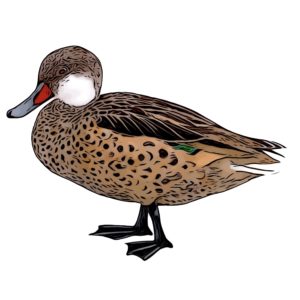Identification
Both males and females are easily distinguished from the samller Blue-winged Teal through their white ‘cheecks’ and the red spot at the base of their bill.
Description
Males have overall buff-brown underparts with dark brown spotts, dark brown backs streaked buff, sharp white tails and a dark brown crown and hind neck contrasting with diagnostic white throat and cheecks. They have blackish legs, a green speculum and a dark bill with a red blotch at its base. Females are virtually alike, but often slightly smaller, paler (particularly on their crowns) and with a marginally reduced, less bright red at the base of their bills. Juveniles resemble pale adults.
Galapagos Distribution
Found on all islands with suitable lagoons or ponds – permanent or ephirnal.
Global Distribution
Outside of the Galapagos, it is patchily distributed along the north and west coasts of south america and throughout most of the carribean. The bulk of its range however, extends across NE Argentina into Uruguy, Paraguay and Bolivia.
Status in the Galapagos
A widespread but uncommon breeding resident. The endemic subspecies which occurs , A.b. galapagensis, is one of three subspecies in the world.
Conservation
Despite the species being listed as Least Concern, due to a population size of only a few thousand individuals (2000 – 5000), some authorities (Threatened Waterfowl Specialist Group) consider the Galapagos race of this species to be endangered. It is threatened by predation from introduced mammals (cats, rats and dogs) and disease.


